This article originally appeared in the May/June 2020 issue of the Ontario Medical Review magazine.
OMA external communications during COVID-19
By early March, it quickly became clear that COVID-19 was going to hit harder in Ontario than many people expected. As Ontario’s Doctors mobilized, so did the OMA to get ahead of member and patient needs.
Efforts revolved around public education and advocacy as everyone across the OMA worked collaboratively to respond to gaps in public information and began lobbying intensively on behalf of members.
The resulting campaigns emphasized the importance of protecting Ontarians during COVID-19 — and supporting the doctors who take care of them.
How would the people of Ontario react, to the pandemic and to accessing health care from their doctor? In a time of crisis and uncertainty, the OMA moved to give the public credible information and address knowledge gaps.
Initially, the focus was on three areas:
magazine, newspaper, digital ads
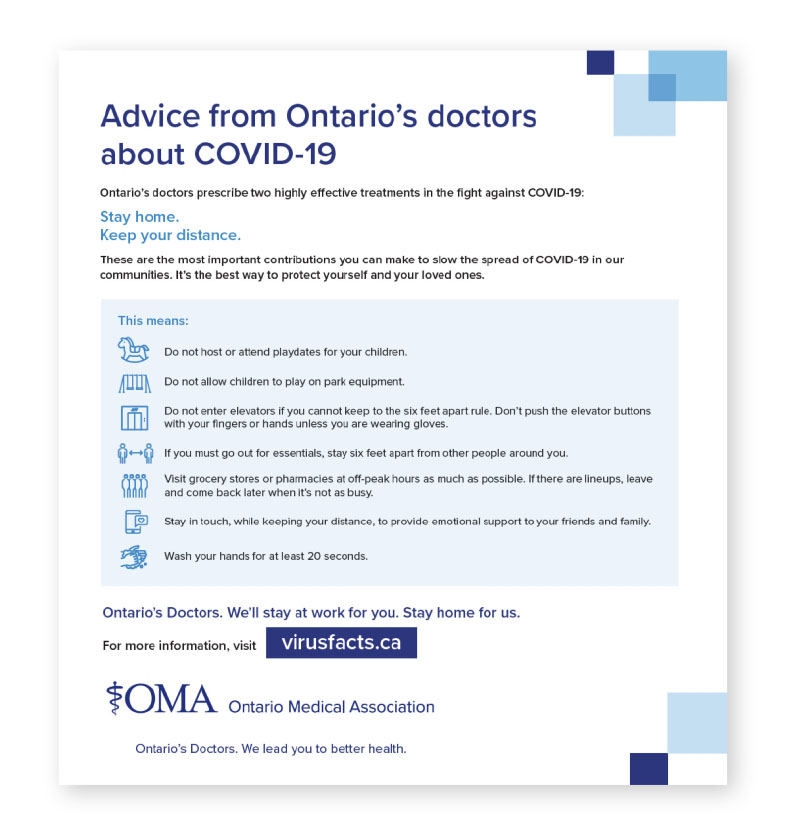
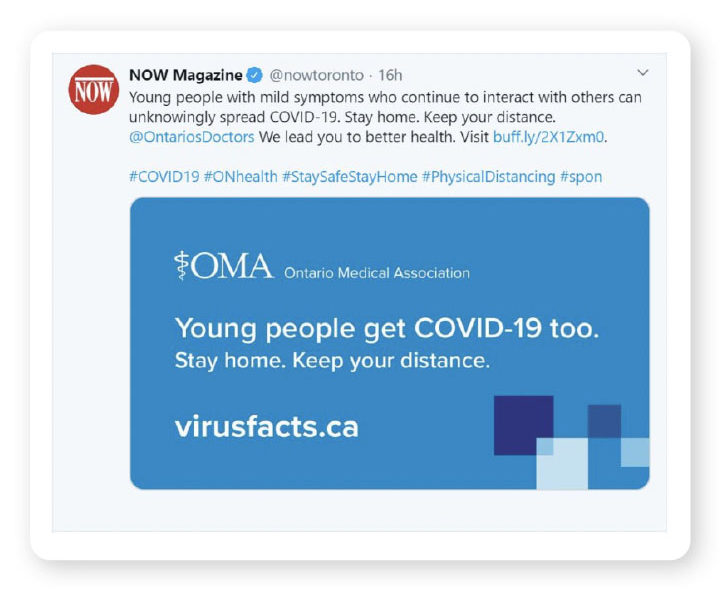
Circumstances dictated shifts in messaging. When cases started to rise, the OMA talked more about physical or social distancing. Then, the province began shutting down businesses and services (except for essential ones). The focus moved to encouraging people to stay home.
Facebook/YouTube videos, Twitter, Instagram
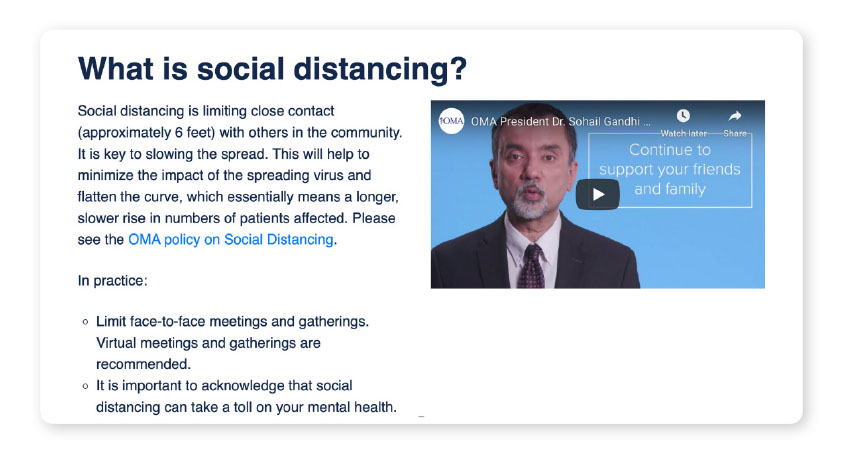
As people were staying home, they still needed to access health care. So there was a need to tell people about virtual care. The OMA emphasized that doctors are still available to serve patients, and that it’s especially important for patients with chronic issues to continue to seek care.
While education was critical to keeping the public safe, advocacy kept the urgent needs of doctors in the forefront.
Meeting the ongoing needs of patients, whether related to COVID-19 or any other requirement, put high demands on doctors. For many, that meant being armed for this battle with the right equipment. For others, it meant pivoting to deliver care differently.
The OMA began intensive lobbying efforts, through all available government channels, around PPE supplies, stable funding and virtual care OHIP codes. The goals were to ensure the supports physicians would need to keep providing excellent patient care, and keep the physician-led health care infrastructure strong. All of the advocacy efforts underscored how the OMA has the backs of all physician members, regardless of their specialty or practice model.
With the COVID-19 situation changing rapidly, the OMA had to be nimble in both educating the public and advocating for members. Here’s how the OMA responded.
Early on in the pandemic, on March 7, the OMA launched virusfacts.ca to provide timely and authoritative information. This was the first time that the OMA has launched a website geared solely to public education with no advocacy component.
The site includes multimedia resources such as podcasts, news stories and videos. This content was supported with organic and paid social media, as well as OMA marketing initiatives. In two months, Virus Facts had almost 250,000 visits.
During that same period, the OMA received over 200 media calls on COVID-19, and the OMA’s spokesperson did more than 90 interviews.
Beyond Virus Facts and media interviews, the OMA launched a public-facing campaign on how to stay safe and healthy. Each wave of public service announcements (PSAs), placed at little to no cost to the OMA, had its own focus:
social media posts, dedicated website
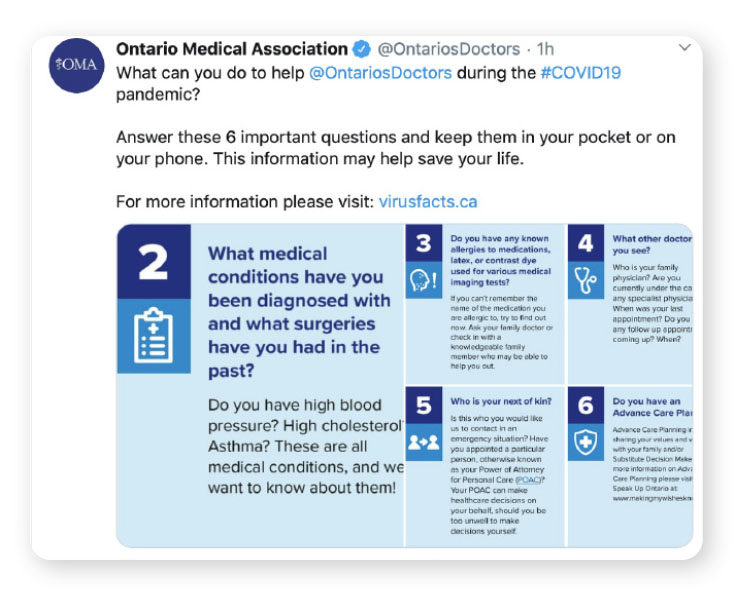
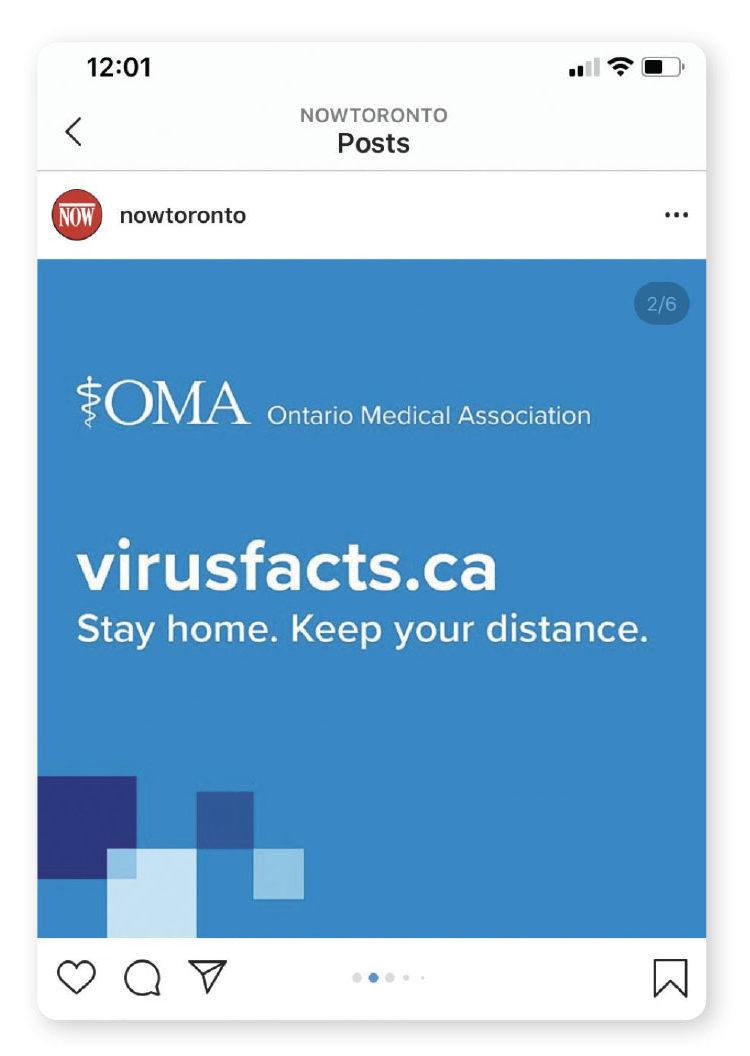
The first wave of advertising started with a 30-second commercial featuring OMA President Dr. Sohail Gandhi (now Past President). It shared five steps the public should take to protect themselves, and drove viewers to Virus Facts for more information.
Disseminating the PSA required flexibility. Cineplex planned on airing it provincewide, but the theatres were closed before they were able to. The commercial was given to Corus, Rogers, and Bell Media, and ran on their TV networks (based on available inventory) until April 15.
The commercial also ran online on the OMA’s Twitter, Facebook, YouTube and Instagram channels, and can be viewed at Virus Facts.
To further support this public safety message, the OMA created a 30-second radio commercial, which ran provincewide (based on available media inventory) from March 16 to April 5.
A series of large-scale billboards also appeared along the Gardiner Expressway in Toronto, as well as in various other locations in Toronto, Oshawa and Hamilton.
To drive home a key aspect of protection, the OMA launched a #handwashchallenge with a video featuring Dr. Gandhi. A number of media and doctors participated, which helped to teach the public about proper handwashing in a fun way. Most notably, the Voices Rock Medicine choir, consisting of female physicians in the Greater Toronto Area, responded to the challenge with a great video of their own.
The second wave of public information focused on social/physical distancing. A 90-second PSA video featuring Dr. Gandhi was promoted via the OMA’s social channels, and directed audiences to Virus Facts.
A second 30-second radio commercial ran in rotation with the five steps radio PSA. The physical distancing PSA ran provincewide (also based on available inventory) from March 24 to April 5, and ran at 100 per cent creative rotation from April 6 to 15.
This phase also included out-of-home billboards, which ran in 50/50 rotation with the phase 1 billboard creative. The physical distancing billboard also ran on digital screens in 800 convenience stores provincewide for three weeks in April.
The OMA created a series of paid animations for social media on the do’s and don’ts of physical distancing. That too drove visitors to Virus Facts.
To reach print audiences, newspaper ads ran in the Globe and Mail. NOW Magazine ran the OMA’s advertising on their outside back cover. The print publication ads were supported by digital banners on NOW Toronto, and on NOW’s social channels throughout much of April.
By this time, the messaging had evolved to stay at home. It was especially important to promote that message during three religious holidays in April that typically have large social and family gatherings: Passover, Easter and Ramadan. Phase 2 ads ran in the Canadian Jewish News (April 9 issue), Catholic Register (April 12 issue) and Muslim Link (starting April 24).
The third wave of advertising focused on virtual care. Members had expressed concern about patients staying home and putting off getting care. On March 14, the Ministry of Health and the OMA agreed on temporary telephone and video fee codes for family physicians and specialists. That would help to ensure care while keeping patients out of waiting rooms, where they could be at risk of infecting others or becoming infected.
To support this change in delivering care, the OMA ran newspaper ads from late March through April in the Globe and Mail, Toronto Star, Sudbury Star, Hamilton Spectator, Parry Sound Beacon, Turtle Island News and NOW. Virtual care messaging was updated throughout this time.
A third 30-second radio commercial was produced focusing on virtual care. It ran from April 17 to May 2 on stations in the GTA, Ottawa, Hamilton, Windsor, St. Catharines, Kitchener, London, St. Thomas and Barrie.
newspaper ads, radio commercials
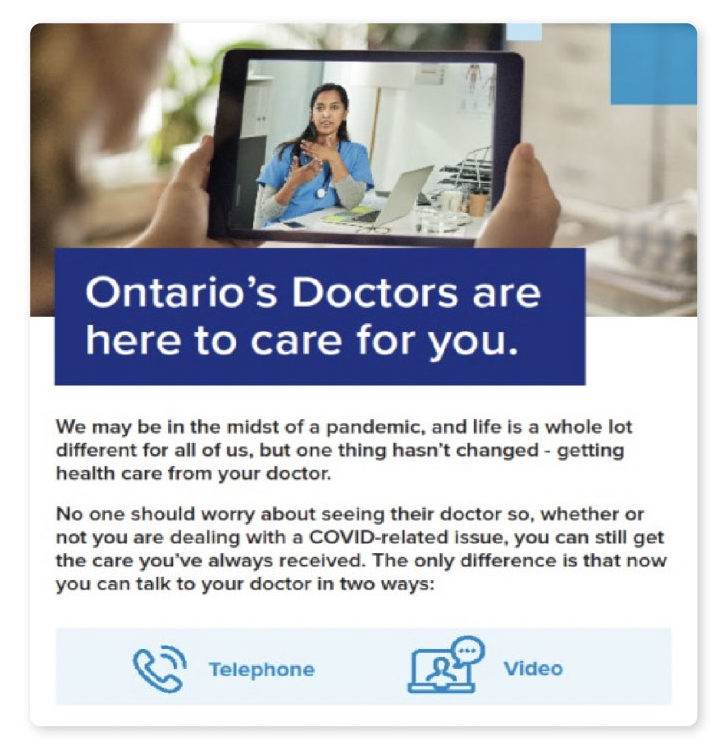
The outreach to the public during COVID-19 was complemented by vital advocacy on behalf of members.
Physicians and our health care system faced many challenges during this unprecedented time. The OMA launched some public advertising to increase the public’s awareness of two issues:
On the PPE front, the OMA campaign included a full-page letter in the Toronto Star on April 4, emphasizing the need for equipment for frontline staff. OMA personnel have also done over 35 interviews about PPE, and the OMA has supported numerous PPE drives with social media and media relations activities.
While doctors face delayed payments, they still need to pay staff and bills. That puts some offices and clinics at risk of closing. More appropriate government funding is needed to protect Ontario’s community health care infrastructure. It’s essential to remain viable through the pandemic, so the infrastructure will be there in full when patients can go back to their GP and specialists’ offices.
The OMA conveyed that message through full-page ads in the Globe and Mail, Toronto Star and community newspapers. The new OMA President Dr. Samantha Hill, and Past President Dr. Gandhi, have conducted dozens of media interviews, and discussions continue on the topic using the hashtag #DoTheRightThing.
Physicians have reached out to tell their stories via blogs and video, which are posted on a new site: Protect Health Care. This is part of a larger OMA effort to advance and escalate this issue on behalf of doctors, in whom public trust is at a record high.
The OMA continues to advocate directly to the Health Minister’s Office, Premier’s Office and MPPs, around virtual care, PPE, the stabilization of health care infrastructure and more
PPE, Financial Support, etc.
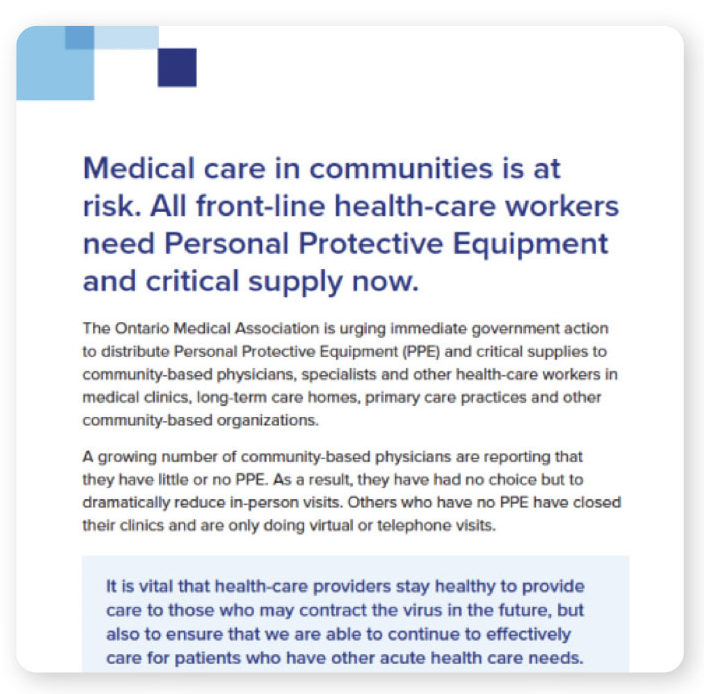
COVID-19 has demanded a widespread response from doctors and the OMA alike. As the pandemic continues, OMA staff remain focused on supporting members. It will happen by both educating Ontarians and advocating for fairer treatment from government — all to keep the public and the system healthy.